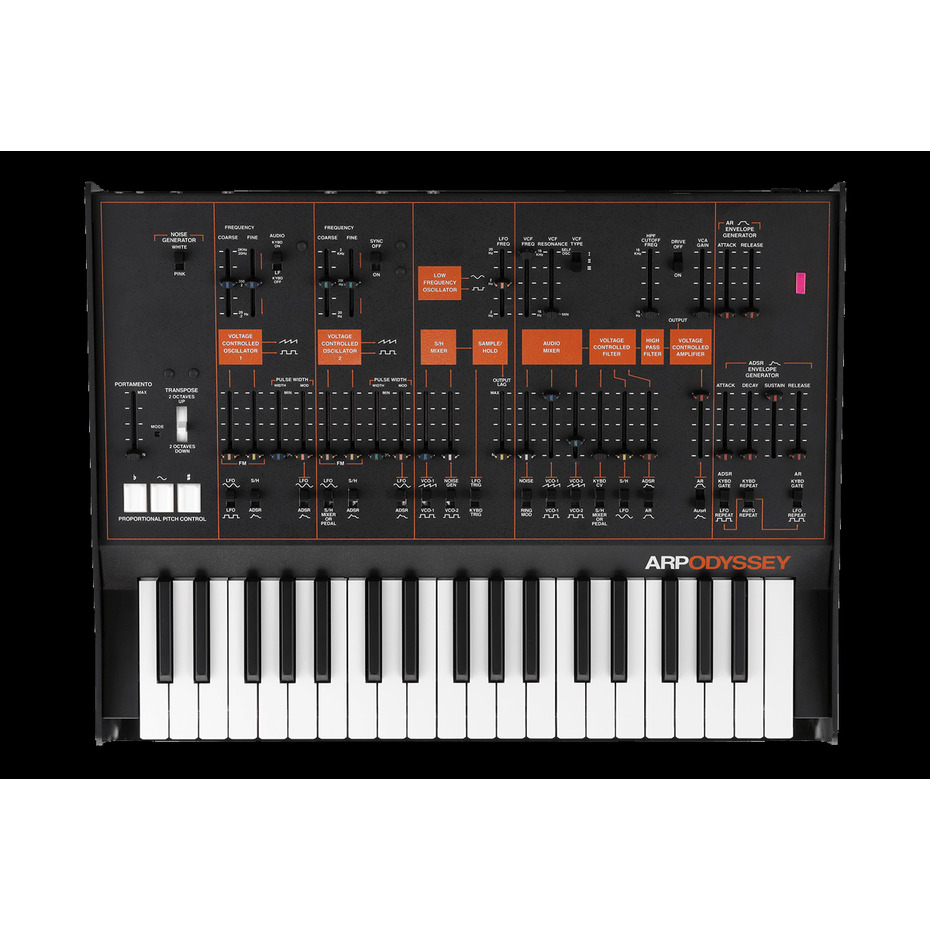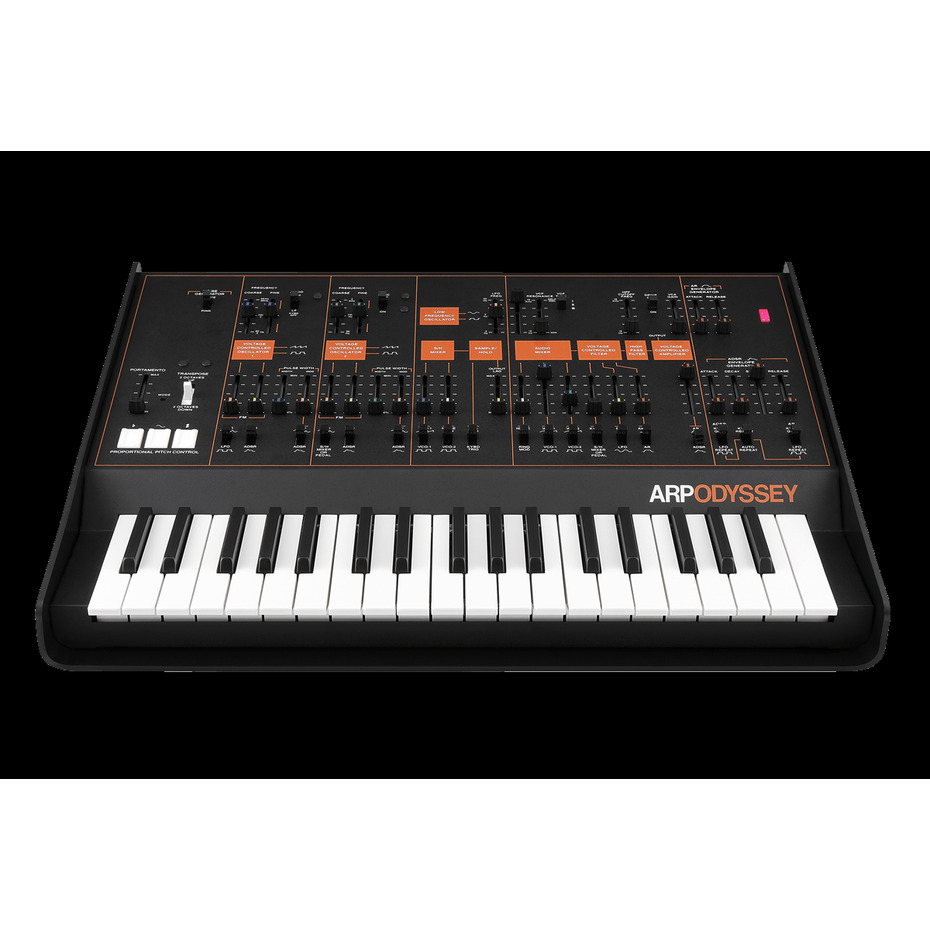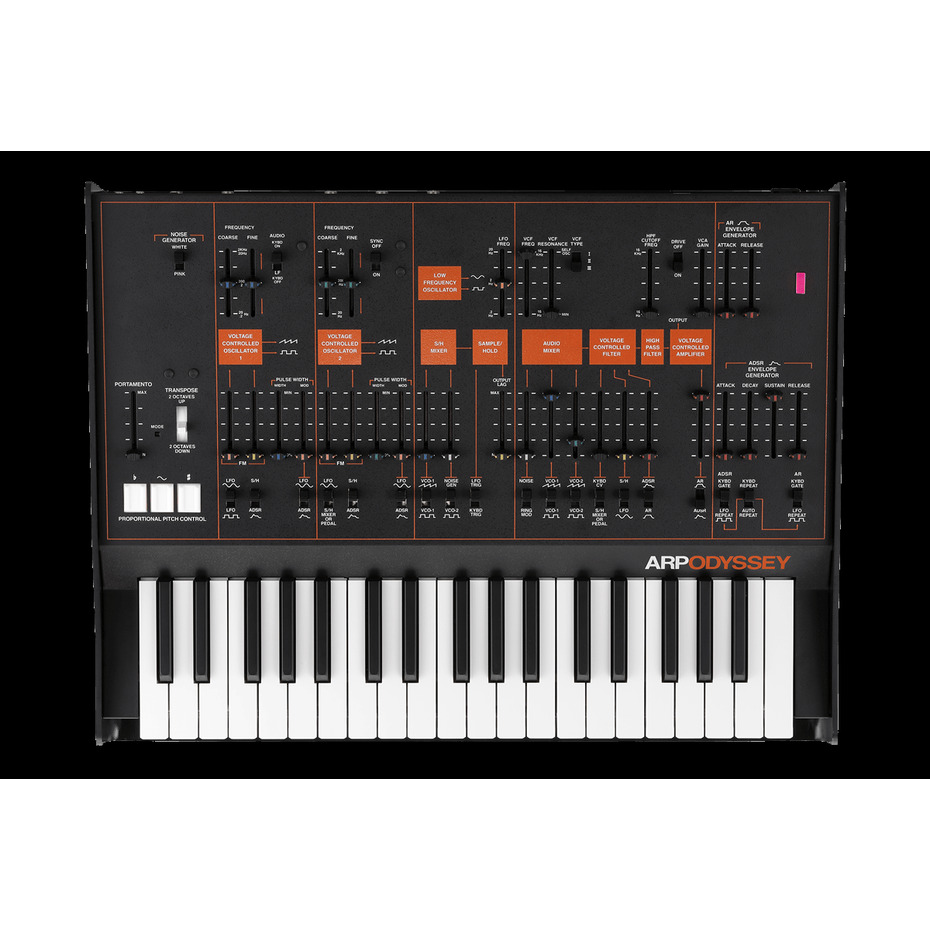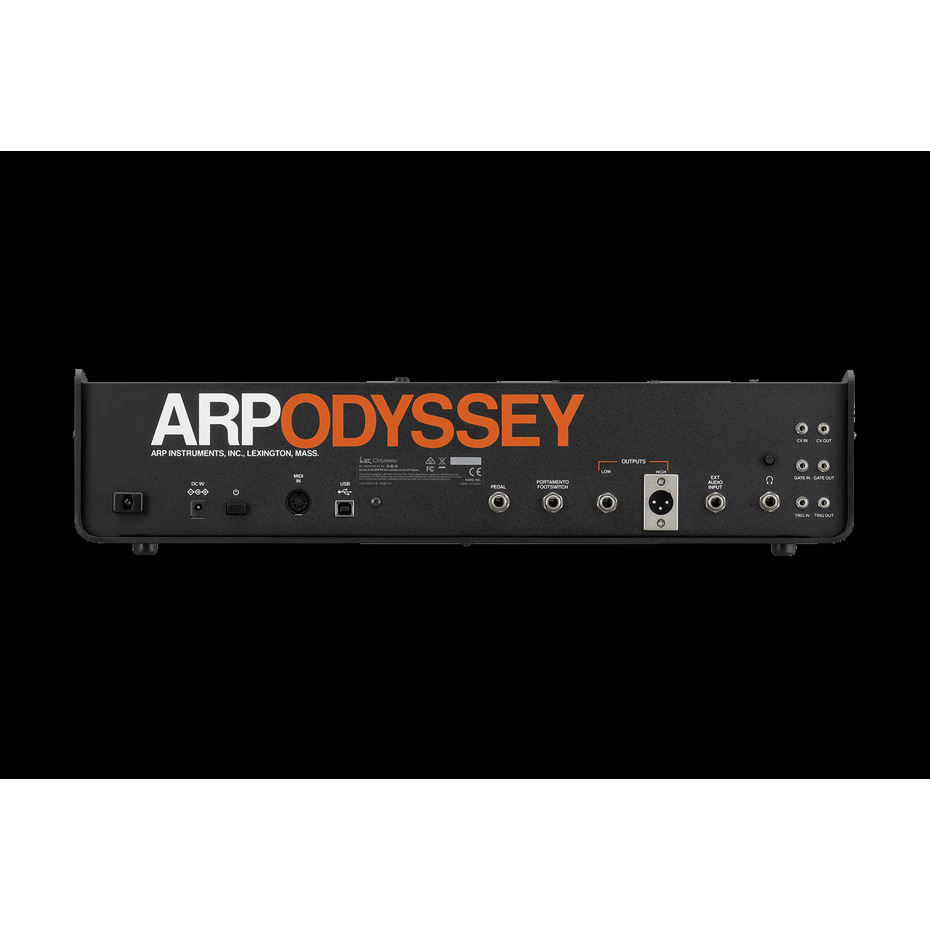Specifications:
- Keyboard: 37-note (Slimkey, No velocity sensitivity, No aftertouch)
- Maximum Polyphony: 2 voices for duophonic; normally monophonic
- Controllers:
- Transpose Positions: 2 octaves down, normal, 2 octave up
- Proportional Pitch Control:
b (Pitch down) Pad: about -2 / 3 octave
- (Modulation) Pad
# (Pitch-up) Pad: about +2 / 3 octave - Noise Generator: Noise Spectrum Types (white and pink)
- Portamento:
- Maximum Speed: about 0.01 msec./oct
- Minimum Speed: about 1.5 sec./oct - VCO (Voltage Controlled Oscillator):
- Waveforms: Sawtooth, Square, Pluse (Dynamic Pluse)
- Frequency Range: VCO-1 in low freq. mode, 0.2 Hz 20 Hz: VCO-1 and VCO-2 (audio range) about 20 Hz 20 kHz
- Warm Up Drift: 1/30 semitone from turn on max
- Pulse Width: 50 % 5 %
- Pulse Width Modulation: ADSR, +45 % / LFO, +15 %
- Voltage Controlled Response: 1 V/oct
- Maximum Frequency Shifts: LFO sin wave, +1/2 oct. LFO square wave, +1.5 oct. ADSR, +9 oct. S/H, +2 oct.* VCO-1 is low note priority, VCO-2 is high note priority. - VCF (Voltage Controlled Filter):
- Types: Low pass (I: 12 dB/oct., II III: 24 dB/oct.)
- Frequency Range: 16 Hz - 16 kHz
- Maximum Usable Q: 30
- Resonance: 1/2 - self oscillate
- Voltage Controlled Response: C3 key (left edge): 0 V. C6 key (right edge) 3 V. - VCA (Voltage Controlled Amplifier): Dynamic Range: 80 dB
- Ring Modulator:
- Type: Digital
- Input Signal: VCO-1, VCO-2 (square wave) - Sample & Hold:
- Command Sources: Keyboard or LFO trigger
- Sampled Signals: VCO-1 sawtooth wave and square wave, VCO-2 square wave and pink noise - ADSR Envelope Generator:
- Attack Time: 5 msec. - 5 sec.
- Decay Time: 10 msec. - 8 sec.
- Sustain Leve: l0 - 100 % or Peak
- Release Time: 15 msec. - 10 sec. - AR Envelope Generator:
- Attack Time: 5 msec. - 5 sec.
- Release Time: 10 msec. - 8 sec. - Control Input Jacks:
- Pedal: 6.3 mm monaural phone jack
- Portamento Foot Switch: 6.3 mm monaural phone jack - Audio Output Jacks - LOW:
- Connector: 6.3 mm monaural phone jack
- Maximum Output Level: -20 dBu@ 10 k load
- Output Impedance: 10 k - Audio Output Jacks - HIGH:
- Connector: XLR connector
- Maximum Output Level: +4 dBu@ 1 k load
- Output Impedance: 330 - Headphones Jack:
- Connector: 6.3 mm stereo phone jack
- Maximum Output Level: 50 mW + 50 mW@ 33 load
- Output Impedance: 10 * Controllable by volume knob. - External Audio Input (Ext Audio Input) Jack:
- Connector: 6.3 mm monaural phone jack
- Maximum Input Level: -10 dBu
- Input Impedance: 22 k - MIDI Connector: IN
- USB Connector: Type B
- CV IN/OUT Jacks:
- Keyboard CV (IN/OUT): 1 V/oct.
- Connector: 3.5 mm monaural phone jack - GATE IN/OUT Jacks:
- GATE IN: +3 V (minimum)
- GATE OUT: +10 V, key down; 0 V all keys up
- Connector: 3.5 mm monaural phone jack - TRIG IN/OUT Jacks:
- TRIG IN: +3 V pulse min., 10 sec. Duration minimum
- TRIG OUT: +10 V pulse on key depression, 10 sec. Duration
- Connector: 3.5 mm monaural phone jack - Power Supply: AC adapter jack (DC 9V)
- Power Consumption: 6.5 W
- Dimensions (W x D x H): 502 x 380 x 120 mm / 19.76" x 14.96" x 4.72"
- Weight: 5 kg / 11.02 lbs
- Included Items: AC adapter, phone cable, mini-phone cable, owners manual, dedicated semi-hard case
- Accessories:
- Expression/Volume Pedal: XVP-20
- Volume Pedal: VP-10
- Pedal Switch: PS-3
- Pedal Switch: PS-1
- Patch Cables: SQ-CABLE-6
Here we have the easy to play & perfectly portable synth ideal for any music producer/DJ in form of the Korg ARP Odyssey. This legendary analogue synthesiser is a great product to have in a studio with its with its compact body, highly operable sliders and slim 37-note keyboard.
Forty years later, a complete revival.
The legendary analog synthesizer that transformed its age.
The ARP Odyssey was an analog synthesizer originally produced in 1972 by the American manufacturer ARP Instruments, Inc. that quickly garnered a faithful following among musicians. Well respected for its high value, ease to play and portability, the ARP Odyssey had undergone several improvements during its history and continued to be a long-seller until manufacturing stopped in 1981 due to economic hardships and the digital surge. Loved by a wide range of musicians as a historical classic, its sound can be heard on numerous classic songs.
Now in 2015, KORG has brought back the ARP Odyssey for today. With the advisory assistance of David Friend, the co-founder of ARP Instruments, KORG has completely reproduced the original circuitry for artists looking to recreate classic sounds and explore new ones. Together the engineers at KORG and Arp were able to nailthe sound and feel of the original. Every detail has been carefully considered to stay true to the quality of the original, down to the sophisticated semi-hard case.
The legendary ARP sound is loved to this day. Long stopped, the wheels of history have again begun to move.
Compact body, highly operable sliders, and a slim keyboard that's easy to play
The ARP Odyssey has been downsized to 86% of the original ARP Odyssey. Carefully selected parts are used in the familiar slider section, providing an operating feel that's even smoother than the original. The keyboard uses a 37-note slim keyboard that features lighter weight and excellent playability. While making the instrument more compact and easier to use, we have also paid attention to ensuring that the mini-keyboard is uncompromisingly "playable." Although the keyboard has 37 keys, the transpose function lets it cover a broad range of seven octaves.
Added connectors such as MIDI and headphone output
The connectors provided on the original ARP Odyssey differed by production date, but based on Rev3 of the original, the ARP Odyssey brings the specifications up to a modern standard. In addition to a MIDI IN connector and USB-MIDI port, we've added a headphone jack with adjustable volume (*). The XLR output jacks which had been unbalanced have been changed to noise-resistant balanced outputs.
Patch cables included
Quarter-inch and mini-size patch cables are included. If you connect a patch cable from the newly added headphone jack to the external audio input jack, you can produce a powerful sound by applying self-feedback. If you connect the GATE OUT jack to the TRIG IN jack, the EG won't be retriggered, allowing you to play legato.





